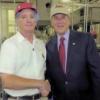Hi everyone!
I'm starting to get a bit confused on the issue of Product Recall vs. Traceability.
Prior to BRC certification, we had considered a mock recall to be a trace of finished product to customers.
Isn't this also one aspect of traceability? If done as a traceability test does it also serve as the mock recall?
And how many conditions of traceability must be tested? ie: raw material forward, finished good backward and forward, packaging material forward.
We received a C grade and so will be re-audited within 6 months. Want to make sure to be prepared, as an A or B is well within reach! ![]()
- Home
- Sponsors
- Forums
- Members ˅
- Resources ˅
- Files
- FAQ ˅
- Jobs
-
Webinars ˅
- Upcoming Food Safety Fridays
- Recorded Food Safety Fridays
- Upcoming Hot Topics from Sponsors
- Recorded Hot Topics from Sponsors
- Food Safety Live 2013
- Food Safety Live 2014
- Food Safety Live 2015
- Food Safety Live 2016
- Food Safety Live 2017
- Food Safety Live 2018
- Food Safety Live 2019
- Food Safety Live 2020
- Food Safety Live 2021
- Training ˅
- Links
- Store ˅
- More



















